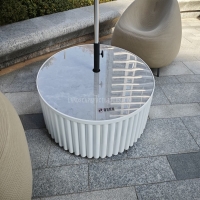Welcome to the website for landscape facilities products and knowledge.
How does the table’s surface texture enhance grip to prevent items from sliding off?
The fundamental principle behind how table surfaces prevent objects from sliding lies in the science of friction and surface texture interactions. When we examine surfaces at a microscopic level, even seemingly smooth tables contain countless minute peaks and valleys that create resistance against objects placed upon them.
Surface texture enhances grip through several mechanisms. First, the roughness creates more contact points between the table and objects, increasing the friction coefficient. This occurs because textured surfaces physically interlock with microscopic imperfections on object bottoms, creating mechanical resistance against sliding forces. Materials scientists have quantified that textured surfaces can increase static friction by up to 40% compared to perfectly smooth surfaces.
Different texture patterns serve distinct purposes. Concentric circular patterns, for instance, provide multidirectional resistance, while linear grooves offer superior resistance against sliding in specific directions. The depth and spacing of these textures determine their effectiveness - textures that are too shallow provide minimal benefit, while excessively deep textures may prevent objects from sitting evenly.
Material composition plays a crucial role in this dynamic. Rubberized textures create molecular-level adhesion through van der Waals forces, while wooden surfaces rely on their cellular structure to create natural gripping surfaces. Modern composite materials often combine multiple approaches, using both mechanical interlocking and chemical adhesion principles.
Environmental factors significantly influence texture effectiveness. Surface textures perform optimally in dry conditions where direct material contact occurs. However, specialized drainage textures become crucial in wet environments, where channeled grooves redirect moisture away from contact points, maintaining direct surface-to-surface contact.
The practical applications extend beyond basic slip prevention. In industrial settings, engineered surfaces with specific texture patterns can secure components during manufacturing processes. Restaurant kitchens utilize strategically textured surfaces to prevent bowl and cutting board movement during food preparation. Even everyday office desks incorporate subtle texturing to keep computer equipment stationary.
Understanding these principles allows for better surface selection for specific needs. High-friction surfaces prove essential in laboratories and workshops where equipment stability is critical, while moderately textured surfaces suffice for general household use. Recent advancements include smart surfaces that can alter their texture properties in response to detected weight or movement, providing adaptive grip solutions.
The relationship between surface texture and slip prevention represents an elegant intersection of physics, materials engineering, and practical design. By manipulating microscopic surface characteristics, manufacturers can create tables that reliably secure everything from delicate glassware to heavy electronic equipment, demonstrating how small-scale engineering solves large-scale stability problems.
Related search:

Recommendation
Round metal tube border design table with tempered glass or granite countertop on the top.